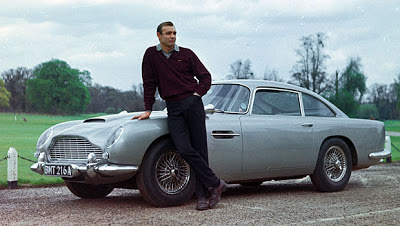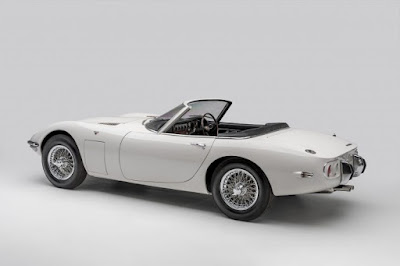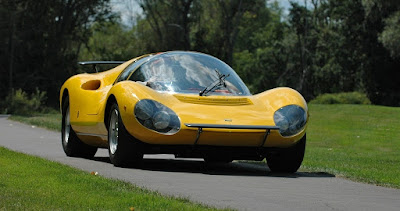This is one and the only car that was born from the magic hand scratches of Virgil Exner Jr., a well-known American automotive designer that has used as his thesis when completing the Master's program at the University of Notre Dame, France in 1955.
 |
The unique-styled SIMCA Special designed by Virgil Exner
Jr. as his thesis when completing the Master's program at the University
of Notre Dame in 1955. (Picture from: https://bit.ly/37NaFIU)
|
This rear double-wings car body that resembles a batmobile is made of fiberglass and worked on by Virgil Exner Jr. himself at the Dual-Ghia assembly plant. This unique car building work was carried out on a 1950 Fiat 1100 chassis which was purchased with the help of Paul Farago, a Dual-Ghia's engineer
.
The used 1950 Fiat 1100 car mechanically was a SIMCA which later in this project functioned as a donor for the chassis and mechanical parts. As information, the SIMCA is a French car manufacturer founded in 1934 by Fiat. The construction work of this unique car carrying a SIMCA-Fiat's 1,200 cc, 4 cylinder engine lasted about 3 years (1956 to 1959).
Finally, the one-off Virgil Exner Jr unique car creation named
SIMCA Special has finished being built and its visual debut featured on the pages of the American magazine 'Road & Track' in April 1959 and then for the first time the car's physical form can be seen and touched in the SIMCA's booth at the 1959 Paris International Motor Show
. |
| The
unique-styled SIMCA Special built based on the used 1950 Fiat 1100 car
mechanically was a SIMCA which later in this project functioned as a
donor for the chassis and mechanical parts. (Picture from: https://bit.ly/37NaFIU) |
After that, this car was sold to a Chrysler dealer who showed it off for years in their showroom. In 1965, the car was purchased by one of Exner's associates named Beau Hickory. And during Hickory's care, the car got the addition of the Opel's panoramic and central cockpit arch windscreen.
Then the car's ownership changed after Hickory sold it to a fanatic fan of French cars in America. But in 1985, Hickory found the car in a neglected condition and the engine had been swapped for a Datsun B210's 1,200 cc, 4 cylinder engine. Then he decided to purchase it back and did restoration work on this car at once. |
| While in Beau Hickory care, the unique-styled SIMCA Special got the addition of the Opel's panoramic and central cockpit arch windscreen. (Picture from: https://bit.ly/37NaFIU) |
And after the restoration process was complete, the car was driven by Beau Hickory for years around San Francisco. Although the engine has been swapped, the rest of the car retains much of Exner Jr.’s original styling cues. And during that time, the SIMCA Special roadster car received good publications and was featured in, among others, the Motor Trend, Vanity Fair, Men's Health and Self. |
| Initially, the unique-styled SIMCA Special uses a SIMCA-Fiat's 1,200 cc, 4 cylinder engine before swapped with a Datsun B210's 1,200 cc, 4 cylinder engine. (Picture from: https://bit.ly/37NaFIU) |
In early 2005, the car was offered for sale at auction in Scottsdale, Arizona. Bidding reached $185,000 but was not enough to satisfy reserve. In 2007, it returned to auction, this time on the east coast at the Kruse auction in Hershey, where it sold for $550,000 inclusive of buyer's premium.
In 2012, the car is scheduled to cross Mecum's auction block where it is offered at No Reserve. It was put up for sale in the USA by Dana Mecum’s at its "25th Original Spring Classic Auction", which took place on May 15-16, 2012. Do You know the Mecum's auction results above? If does, let's Us know through the comment section below
. *** [EKA | FROM VARIOUS SOURCES | CONCEPTCARZ.COM | CARSTYLING.RU | JOURNAL.CLASSICCARS.COM | WIKIPEDIA]
Note: This blog can be accessed via your smart phone


 Actually the Carlo Abarth established the auto brand in 1947 as an independent car manufacturer, and not affiliated with any other brands. As we all know, Abarth progressed to become an independent automaker is started with a couple of half-finished Cisitalia 2013 car types, then completing the cars and named the Abarth 204A.
Actually the Carlo Abarth established the auto brand in 1947 as an independent car manufacturer, and not affiliated with any other brands. As we all know, Abarth progressed to become an independent automaker is started with a couple of half-finished Cisitalia 2013 car types, then completing the cars and named the Abarth 204A.




















































